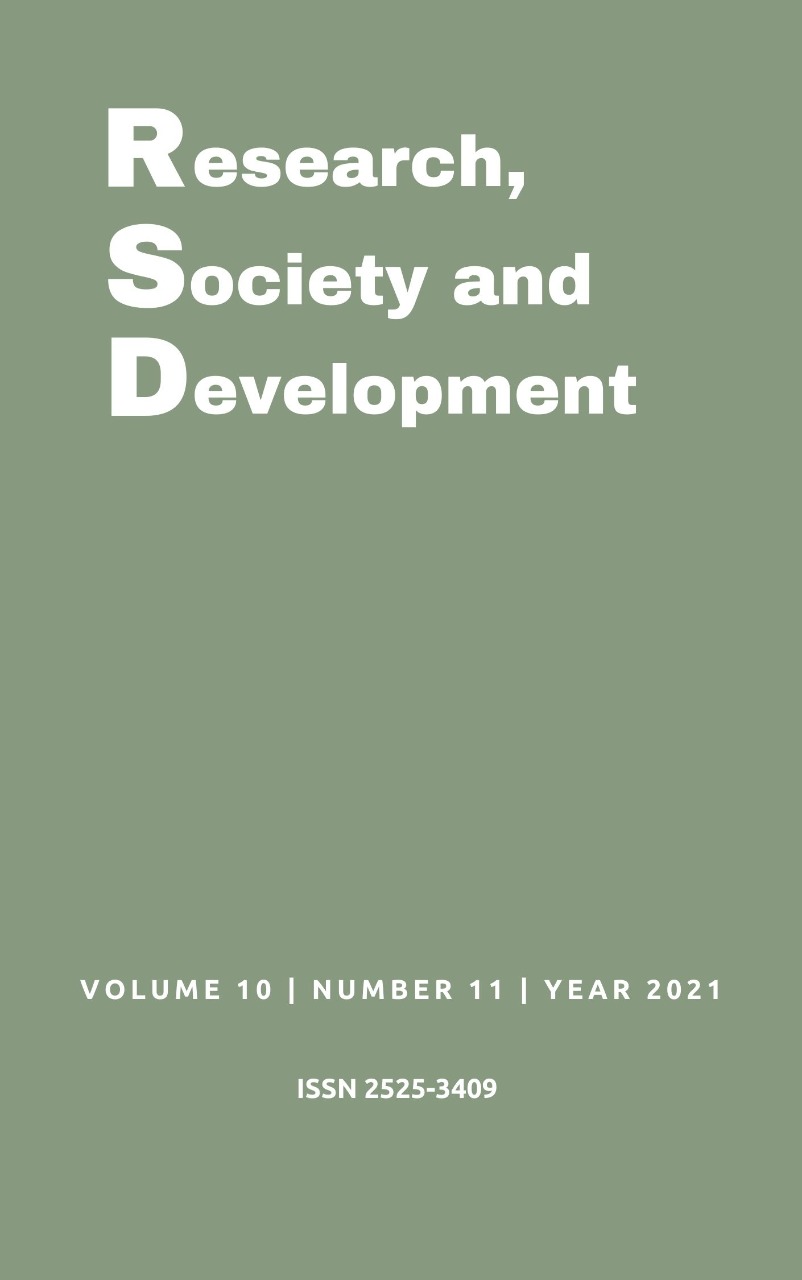Descriptive study of the anatomy of the lumbosacral plexus in Amazona amazonica (Linnaeus, 1766)
DOI:
https://doi.org/10.33448/rsd-v10i11.19600Keywords:
Nerve, Parrot, Psittaciformes.Abstract
The amazon genus comprises parrots which are among the most popular birds as pets, precisely because of their docile habit and ability to reproduce sounds. They have zygodactyl feet, curved and developed beak, which give the ability to climb trees and ability to handle food. This project aimed to describe the anatomy of the lumbosacral plexus of 10 (ten) specimens of mangrove parrot (Amazona amazonica) donated to the Veterinary Anatomy Laboratory of the Federal University of Campina Grande by CETAS / IBAMA-PB. The animals were fixed and preserved in 10% formaldehyde solution and the lumbosacral plexus nerves were subsequently dissected. The lumbar plexus is formed by the roots of the lumbar nerves 1, 2 and 3; the sacral plexus is formed by the roots of the sacral nerves 1, 2, 3, 4 and 5 and the pudendal plexus has 4 origins from the sacral segments of the spinal cord. The lumbar plexus after branching forms two main nerves, the lateral femoral cutaneous and the cranial femoral cutaneous. From the sacral plexus arises the sciatic nerve, from which four branches originate: tibial nerve, common fibular nerve, caudal femoral cutaneous nerve and thigh caudal nerve. The sciatic nerve innervates all the musculature that act on the knee and finger joints. In general the origin and branches of the lumbosacral plexus are similar in poultry.
References
Akbulut, Y., Demiraslan, Y., Aslan, K. & Coban, A. (2016). The macroanatomy of the sacral plexus and its nerves in Eurasian Eagle Owls (Bubo bubo). Anatomia, Histologia, Embryologia, 45, 367-372.
Balkaya, H. & Ozudogru, Z. (2013). Macroanatomic and subgros study on the plexus lumbosacralis and its branches of pigeon (Columba livia). Ataturk Universitesi Veteriner Bilimleri Dergisi, 8.
Balkaya, H., & Ozudogru, Z. (2015). Macroanatomical aspects of the sacral plexus and its branches in sparrowhawk. Journal of Applied Animal Research, 44 (1), 77-82.
Can, M. & Özdemir, D. (2011). Macro-anatomic investigations on the plexus lumbosacrales of Japanesse Quail (Coturnix coturnix japonica). Ataturk Universitesi Veteriner Bilimleri Dergisi, 6 (1), 31-45.
Cubas, S. Z., Silva, R. C. J. & Dias, C. L. J. (2014). Tratado de animais selvagens. Medicina veterinária. (2a ed.), Rocca.
Dyce, K. M., Sack, W. O., & Wensing, C. J. G. (2010). Tratado de anatomia veterinária. (4a ed.), Elsevier.
Eh-Mahdy, T., El-Nahla, S. M. & Abbott, L. C., Hassan, S. A. M. (2010). Innervation of the pelvic limbo f the adult ostrich (Struthio camelus). Anatomia, Histologia, Embryologia, 39, 411-425.
Getty, R. (1986). Anatomia dos animais domésticos. (5a ed.), Guanabara Koogan.
Harcour-Brown, N. H. (2002). Orthopedic conditions that affect the avian pelvic limb. Veterinary Clinics of North America: Exotic Animal Practice, 5 (1), 49-81.
Honorato, A. G. O. (2017). Origem e distribuição dos nervos do plexo lumbosacral da pelve e coxa em avestruz (Struthio camelus).41f. Tese (Doutorado em Ciências veterinárias) - Universidade Federal de Uberândia.
Hussam, M. T., Islam, M. S. & Alam, J. (2018). Macroanatomical structure of the lumbosacral plexus and its branches in the Indigenous Duck. Bangladesh Veterinary Journal, 52 (1-4): 1-9.
I.C.V.G.A.N – International Committee on Veterinary Gross Anatomical Nomenclature, W.A.V.A. – World Association of Veterinary Anatomists. (2012). Nomina Anatomica Veterinaria. Hannover: Editorial Committee.
Istanbullugil, F. R., Karadag, H., Sefergil, S., Gezer Ínce, N. & Alpak, H. (2013). Formation of the plexus sacralis in pheasants (Phasianus colchicus mongolicus) and macroanatomic investigation of the nerves originating from the plexus sacralis. Turkish Journal of Veterinary and Animal Sciences, 37: 160-163.
Kara, H. & Özdemir, D. (2019). Gross anatomy of the lumbar plexus of magpie (Pica pica) and chukar partridge (Alectoris chukar). Turkish Journal of Veterinarya and Animal Sciences, 43: 642-649.
Necker, R. (2006). Specializations in the lumbosacral vertebral canal and spinal cord of birds: evidence of a function as a sense organ which is involved in the control of walking. Journal of Comparative Physiology A: Neuroethology Sensory Neural Behavioral Physiology, 192: 439-448.
Necker, R. (2005). The structure and development of avian lumbosacral specializations of the vertebral canal and the spinal cord with special reference to a possible function as a sense organ of equilibrium. Anatomy and Embryology, 210: 59-74.
Nickel, R., Schummer A. & Seifirle, E. (1977). Anatomy of the domestic birds. Verlag Paul Parey Berlin.
Pereira, A. S., Shitsuka, D. M., Parreira, F. J. & Shitsuka, R. Metodologia da Pesquisa Científica. UFSM.
Peron, F. & Grosset, C. (2014). The diet of adult psittacids: veterinarian and ethological approaches. Journal of Animal Physiology and Animal Nutrition, 98 (3), 1-14.
Proctor, N. S. & Lynch, P. J. (1993). Manual of ornithology: avian structure and function. Yale University.
Sick, H. (2001). Ornitologia brasileira. Nova Fronteira.
Downloads
Published
Issue
Section
License
Copyright (c) 2021 Luan Nascimento Batista; Moana Barbosa dos Santos Figuerêdo; Joyce Galvão de Souza; Brunna Muniz Rodrigues Falcão; Ediane Freitas Rocha; Temístocles Soares de Oliveira Neto; Gildenor Xavier Medeiros

This work is licensed under a Creative Commons Attribution 4.0 International License.
Authors who publish with this journal agree to the following terms:
1) Authors retain copyright and grant the journal right of first publication with the work simultaneously licensed under a Creative Commons Attribution License that allows others to share the work with an acknowledgement of the work's authorship and initial publication in this journal.
2) Authors are able to enter into separate, additional contractual arrangements for the non-exclusive distribution of the journal's published version of the work (e.g., post it to an institutional repository or publish it in a book), with an acknowledgement of its initial publication in this journal.
3) Authors are permitted and encouraged to post their work online (e.g., in institutional repositories or on their website) prior to and during the submission process, as it can lead to productive exchanges, as well as earlier and greater citation of published work.


